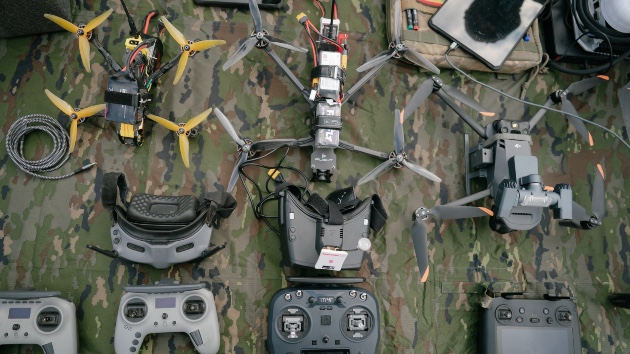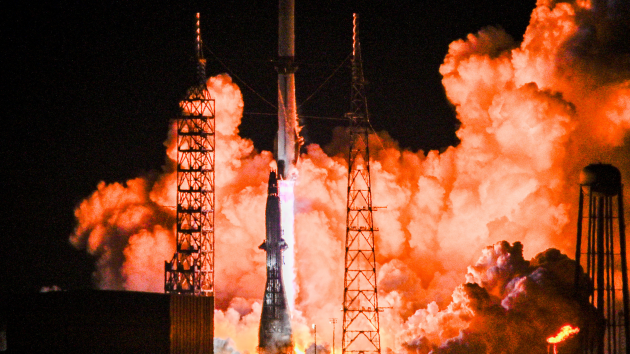Climate change is making climbing in the Himalayas more challenging, experts say
Written by ABC Audio ALL RIGHTS RESERVED on September 26, 2023

(NEW YORK) — Climbing Mount Everest is one of the most difficult feats known to humankind, but the treacherous expedition is getting even more challenging due to climate change, according to experts.
Warming temperatures around the globe are making both the topography of the glaciers in the Himalayas and the weather patterns mountaineers rely on to plan the timing of their journeys more unpredictable, climbing experts and climatologists told ABC News.
A record number of people died while attempting to climb Mount Everest this year. While the Nepalese government blamed climate change for the extraordinary number of deaths, experts say global warming may not be entirely responsible.
This is how climate change is affecting climbing in the Hindu Kush Himalaya mountain ranges:
The topography of the glaciers, mountains are less reliable
Research in recent years has overwhelmingly shown that glaciers in the Himalayas are thinning, Joseph Shea, an associate professor of environmental geomatics at the University of Northern British Columbia, told ABC News. Climate change is roasting the Himalaya region, causing glaciers to retreat and permafrost to melt, according to a 2019 report authored by Shea.
Several of the routes that climbers use to gain access to higher peaks rely on the stability of glaciers, such as the Khumbu Icefall, located near the Everest base camp and used to trek up to Camp 1, Shea said.
“The Khumbu Icefall, which is already really difficult to navigate, that becomes less reliable,” said Shea, who was been researching the Himalayas since 2012.
Researchers have drilled into the Khumbu Glacier near the Everest base camp and found that it is “very close to the melting point,” Duncan Quincey, a professor of glaciology at the University of Leeds, told ABC News.
With just a small increase in atmospheric temperatures, the Khumbu Glacier won’t be far from being in a scenario where it will start to melt rapidly, Quincey said.
Climate change can also exacerbate other risks like rockfall events, especially in the high mountain areas because many of the formations in the highest levels are held together by alpine permafrost, or frozen ground that then thaws, Shea said.
Before the region began to warm rapidly, climbers could have more confidence in passing some of these treacherous areas because everything was “very much frozen” and much more stable, Quincey said.
Many of the slopes are becoming exposed for the first time, and rock avalanche events will be increasingly unpredictable, Quincey said.
Snow and ice avalanches in the Himalayas are also increasing risks for climbers as global temperatures warm, a study published in the European Geosciences Union in July found.
“And as we go forward, I think we can expect the whole region to become a lot more hazardous,” Quincey said.
Everest’s perfect weather window is becoming more unpredictable
Weather patterns in the region are also becoming more erratic, making it difficult for climbers to plan safe expeditions from more than a few days out, research shows.
Everest experts know that there is a “magical” window in May in which the winds die down below 30 mph, typically between May 15 and May 30, Chris Tomer, a Colorado-based meteorologist and weather forecaster for mountaineering expeditions, told ABC News.
The window tends to appear as the monsoon season approaches and the jet stream, an area of high wind that typically sits on the summit, gets pushed off, allowing the winds in the region to drop dramatically and improving conditions for climbing, Tomer said. But that timing has been changing.
Typically, if winds are above 30 mph, most people will not climb, Alan Arnette, a seasoned mountaineer who is the oldest American to climb K2 at 58 years old, told ABC News.
“It’s just too dangerous, and it increases the chance of frostbite and other problems,” he said.
“What I’ve noticed is that it’s become a little bit harder to predict, and it’s a little bit more erratic,” Tomer said.
In 2019, there were only three days — as opposed to the typical 11 to 14 days — where winds were suitable for climbing, Arnette said. But in May 2022, nearly the entire month had favorable wind conditions, something that has never happened before, he said.
“That shows you the extremes that are happening,” he said.
It’s not clear what will happen in the future in terms of jetstream position and the timing of the wind switch, Shea said.
While the long-term forecasts for the perfect window may ultimately change in the future, the short-term forecasts will remain accurate, Shea said.
“Once you’re up there, you have to decide if you’re going to make that call to go for it or not,” he said.
Himalayas region a key indicator of climate change
Most glacier mountain regions around the world are exhibiting clear examples of climate change, the experts said.
Research shows that if greenhouse gas emissions are not drastically reduced, glaciers will keep losing mass and retreating drastically, Shea said.
“This is a very clear climate change signal,” Shea said. “And models that we use to look at what happens in the future predict the same thing, like big declines in total glacier volumes, glacier extents.”
For those who have studied the region for years, the changes are apparent to the naked eye, including exposed slopes on the flanks of the main glaciers and lakes of water pooling on the ice surfaces that were free of meltwater, Quincey said.
“It’s very, very difficult not to see the impacts of climate change,” Quincey said. “There’s some very clear visual indicators of the impact that climate is having in that region.”
Climate change likely not the culprit for majority of deaths on Everest this year
Seventeen climbers died while trying to Everest this year, an extraordinary figure compared to the average of four to six climbers per season, Arnette said.
While the Nepalese government blamed the steep increase in Everest fatalities on climate change, inexperienced and ill-equipped or unqualified guides is likely to blame for the majority of the deaths, the climbing experts said.
Of the 17 people who died, 11 of the deaths were preventable, Arnette said. Several of the deaths were blamed on natural causes, which is typical, Arnette said.
“It is to be expected that you’re going to have people that are going to die from natural causes when climbing Everest because the lower amount of oxygen, and then the exertion that the body goes through climbing at that altitude is stresses the body,” Arnette said.
The only year that saw just as many deaths was in 2014 when 17 people also died — but the majority of the deaths were sherpas who were killed in a single avalanche.
In addition, there were a record number of climbers in 2023, Shea said, which increased the likelihood of more deaths.
Nepal issued a record 478 climbing permits to foreigners for 2023, Arnette wrote in his blog. When accounting for the number of sherpas accompanying the foreigners, the number jumps to about 1,200 climbers pursuing Everest’s summit over the spring.
The unpredictability of the weather patterns could also lead to overcrowding on the summit. If forecasters can only predict conditions with certainty four or five days out, it forces everybody into a smaller summit window, Tomer said.
“Instead of being able to spread 400 people out over five days, everybody gets crammed into a one or two-day window,” Tomer said.
Copyright © 2023, ABC Audio. All rights reserved.
 KVSP
KVSP 




